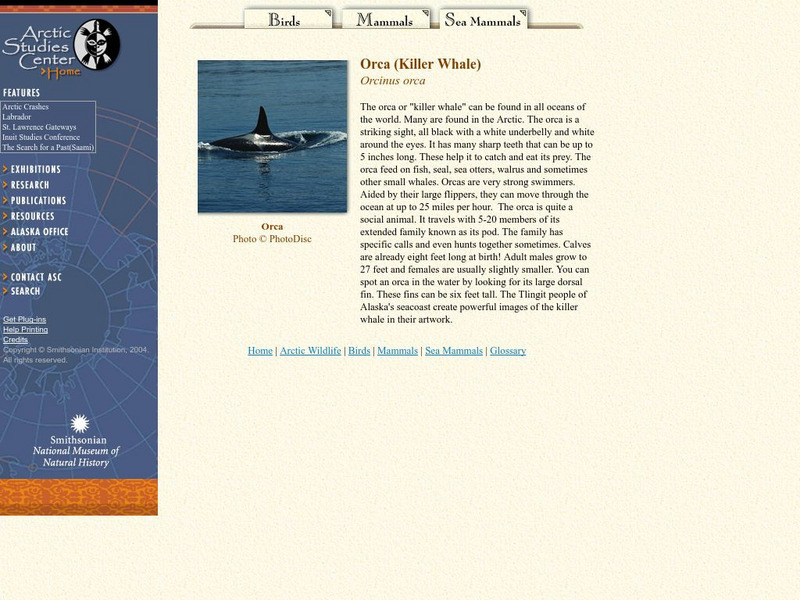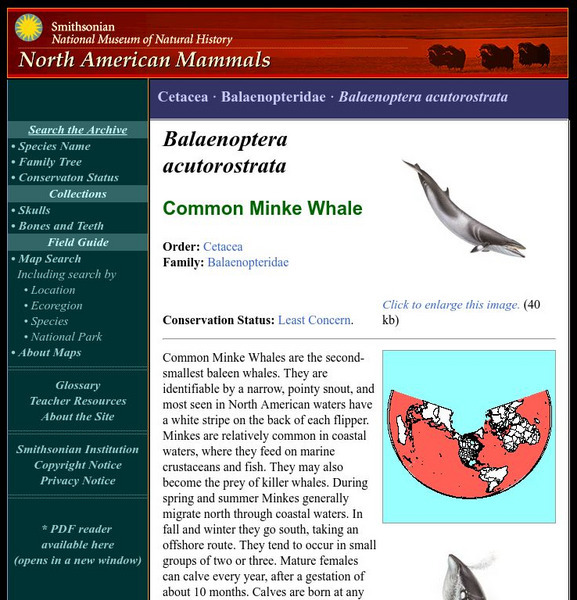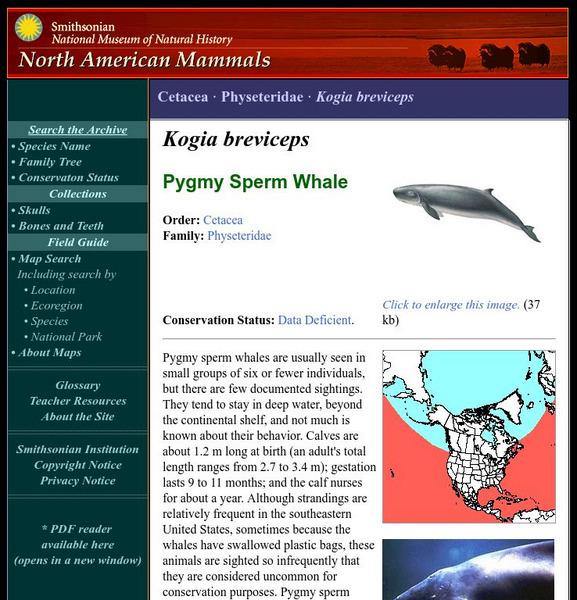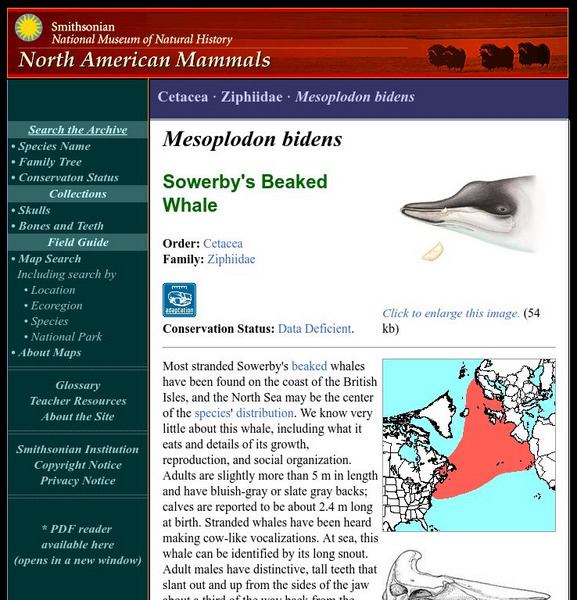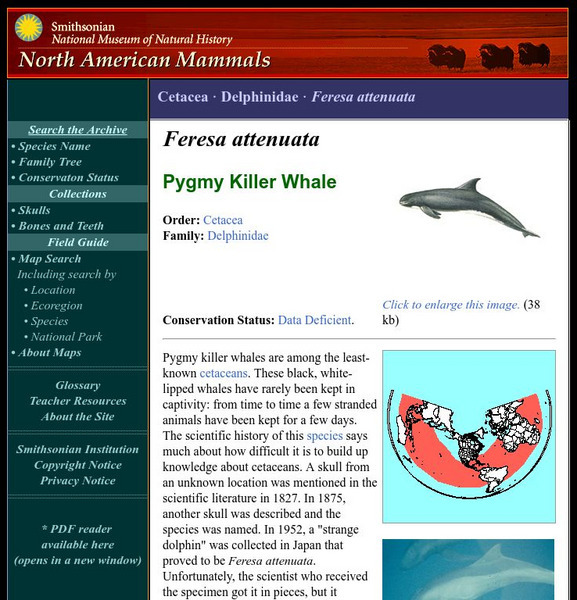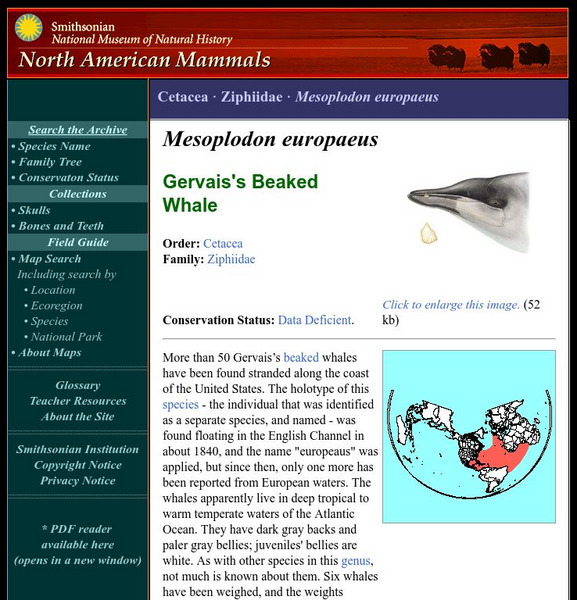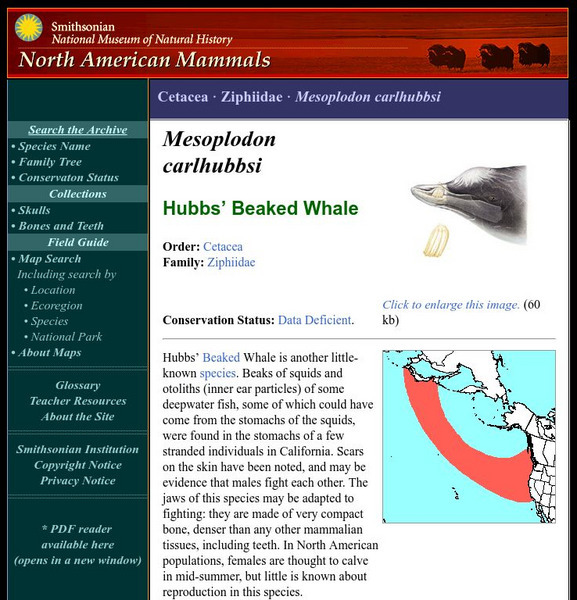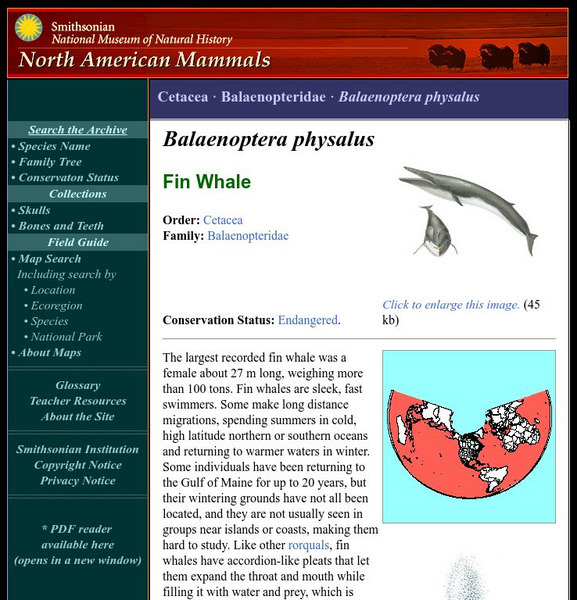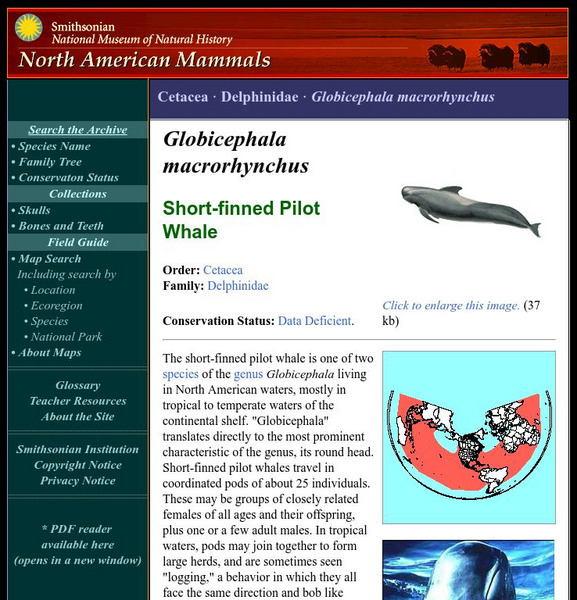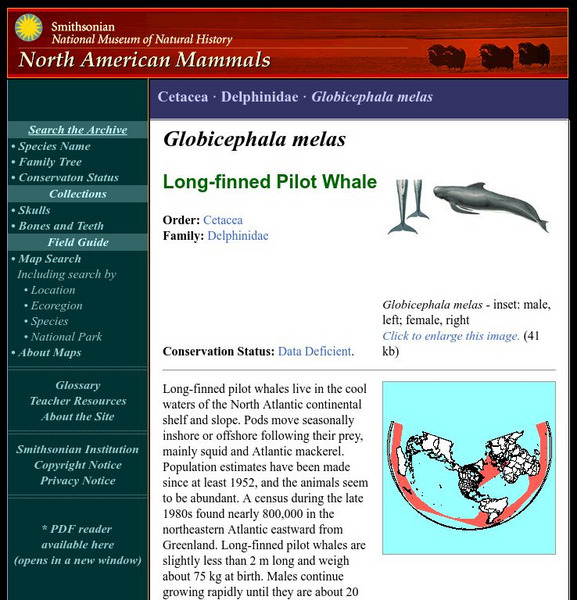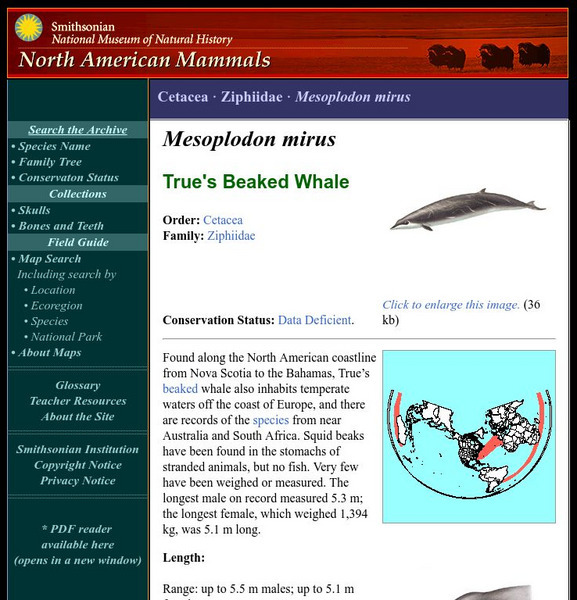Hi, what do you want to do?
Annenberg Foundation
Annenberg Learner: Journey North: Meet the Whale Expert: Anne Smrcina
Meet the Whale Expert, Anne Smrcina! Learn about her exciting career working with humpback whales.
Smithsonian Institution
National Museum of Natural History: Arctic Studies Center: Killer Whales
This site provides a very brief overview of the orca or "killer whale."
Smithsonian Institution
National Museum of Natural History: American Mammals: Baird's Beaked Whale
Baird's beaked whale is the longest species of the Ziphiidae, which is a family of medium-sized whales. The name "beaked whale" comes from the way the long snout, or rostrum, tapers to a tip. Learn more about the Berardius bairdii, more...
Smithsonian Institution
National Museum of Natural History: American Mammals: Common Minke Whale
Common Minke Whales are the second-smallest baleen whales. They are identifiable by a narrow, pointy snout, and most seen in North American waters have a white stripe on the back of each flipper. Learn more about the Balaenoptera...
Smithsonian Institution
National Museum of Natural History: American Mammals: Blainville's Beaked Whale
Blainville's beaked whale is found worldwide in warm temperate to tropical waters. Small pods of 3-7 whales have been seen off Hawaii in waters 700 to 1,000 m deep, near much deeper water. Learn more about the Mesoplodon densirostris,...
Smithsonian Institution
National Museum of Natural History: American Mammals: Pygmy Sperm Whale
Pygmy sperm whales are usually seen in small groups of six or fewer individuals, but there are few documented sightings. They tend to stay in deep water, beyond the continental shelf, and not much is known about their behavior. Learn...
Smithsonian Institution
National Museum of Natural History: American Mammals: Sowerby's Beaked Whale
Most stranded Sowerby's beaked whales have been found on the coast of the British Isles, and the North Sea may be the center of the species' distribution. We know very little about this whale, including what it eats and details of its...
Smithsonian Institution
National Museum of Natural History: American Mammals: Sperm Whale
Sperm whales can dive deeper than 1.6 km and stay under for 90 minutes, although shorter, shallower dives are more usual. Learn more about the Physeter catodon (Physeter macrocephalus), more commonly known as a Sperm Whale, in this...
Smithsonian Institution
National Museum of Natural History: American Mammals: North Pacific Right Whale
The right whales have been driven nearly to extinction as the species preferred by commercial whalers and have been hunted in spite of international bans. There are perhaps several hundred in the western Pacific, and perhaps only a...
Smithsonian Institution
National Museum of Natural History: American Mammals: Pygmy Killer Whale
Pygmy killer whales are among the least-known cetaceans. These black, white-lipped whales have rarely been kept in captivity: from time to time a few stranded animals have been kept for a few days. Learn more about the Feresa attenuata,...
Smithsonian Institution
National Museum of Natural History: American Mammals: Gervais's Beaked Whale
More than 50 Gervais's beaked whales have been found stranded along the coast of the United States. The holotype of this species - the individual that was identified as a separate species, and named - was found floating in the English...
Smithsonian Institution
National Museum of Natural History: American Mammals: Hubbs's Beaked Whale
Hubbs's beaked whale is another little-known species. Beaks of squids and otoliths (inner ear particles) of some deepwater fish, some of which could have come from the stomachs of the squids, were found in the stomachs of a few stranded...
Smithsonian Institution
National Museum of Natural History: American Mammals: Fin Whale
The largest recorded fin whale was a female about 27 m long, weighing more than 100 tons. Fin whales are sleek, fast swimmers. Learn more about the Balaenoptera physalus, more commonly known as a Fin Whale, in this easy-to-read species...
Ducksters
Ducksters: Blue Whale for Kids: Learn About the Giant Mammal.
What are blue whales? Kids find out about the largest mammal on earth that lives in the ocean.
Science4Fun
Science4 Fun: Whale
Learn about the appearance, diet, habitat, conservation, and other fun facts about the largest living animal.
Canadian Museum of Nature
Canadian Museum of Nature: Blue Whale
The blue whale is believed to be the largest animal that has ever existed on Earth, even larger than dinosaurs were. These gentle creatures are at risk and only about 10,000 remain today. Learn some interesting facts about them here.
Smithsonian Institution
National Museum of Natural History: American Mammals: Blue Whale
As far as we know, the blue whale is the largest animal ever to have existed on the planet. Weights up to 190,000 kg (as much as 30-40 African elephants) have been recorded. Learn more about the Balaenoptera musculus, more commonly known...
Smithsonian Institution
National Museum of Natural History: American Mammals: Northern Right Whale Dolphin
With no dorsal fin, a slender body shape that tapers steadily toward the tail, and small flippers and flukes, the northern right whale dolphin appears to be built for speed. It has been clocked at 34 km per hour and can dive as deep as...
Smithsonian Institution
National Museum of Natural History: American Mammals: Ginkgo Toothed Beaked Whale
Almost nothing is known of the ginkgo-toothed beaked whale. Nothing about its behavior or feeding habits has been reported, and its geographical distribution is estimated from a very small sample. Learn more about the Mesoplodon...
Smithsonian Institution
National Museum of Natural History: American Mammals: Short Finned Pilot Whale
The short-finned pilot whale is one of two species of the genus Globicephala living in North American waters, mostly in tropical to temperate waters of the continental shelf. "Globicephala" translates directly to the most prominent...
Smithsonian Institution
National Museum of Natural History: American Mammals: Long Finned Pilot Whale
Long-finned pilot whales live in the cool waters of the North Atlantic continental shelf and slope. Pods move seasonally inshore or offshore following their prey, mainly squid and Atlantic mackerel. Learn more about the Globicephala...
Smithsonian Institution
National Museum of Natural History: American Mammals: True's Beaked Whale
Found along the North American coastline from Nova Scotia to the Bahamas, True's beaked whale also inhabits temperate waters off the coast of Europe, and there are records of the species from near Australia and South Africa. Squid beaks...
Smithsonian Institution
National Museum of Natural History: American Mammals: Sei Whale
Unlike other rorquals, Sei whales have a dolphin-like dorsal fin. They are also unusual in using two different methods to fill their mouths with water during feeding - they both gulp and skim-feed. Learn more about the Balaenoptera...
Smithsonian Institution
National Museum of Natural History: American Mammals: Stejneger's Beaked Whale
Thirty-one of the 48 sightings of Stejneger's beaked whale have come from Alaskan waters. It is suspected this species favors deep waters, including the Aleutian Trench and the Aleutian Basin, which is some 3,500 m deep, rather than the...
Other popular searches
- Killer Whales
- Blue Whales
- Humpback Whales
- Baleen Whales
- Marine Science Whales
- Orca Whales
- Gray Whales
- Uses of Whales
- Language Arts Whales
- Beluga Whales
- Saving Right Whales
- Toothed Whales






